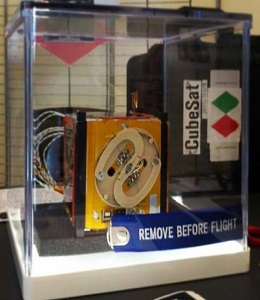
Vega is an expendable launch system in use by Arianespace jointly developed by the Italian Space Agency (ASI) and the European Space Agency (ESA). Development began in 1998 and the first launch took place from the Centre Spatial Guyanais on 13 February 2012.

A CubeSat is a class of miniaturized satellite based around a form factor consisting of 10 cm (3.9 in) cubes. CubeSats have a mass of no more than 2 kg (4.4 lb) per unit, and often use commercial off-the-shelf (COTS) components for their electronics and structure. CubeSats are put into orbit by deployers on the International Space Station, or launched as secondary payloads on a launch vehicle. As of August 2021, more than 1,600 CubeSats have been launched.

A small satellite, miniaturized satellite, or smallsat is a satellite of low mass and size, usually under 1,200 kg (2,600 lb). While all such satellites can be referred to as "small", different classifications are used to categorize them based on mass. Satellites can be built small to reduce the large economic cost of launch vehicles and the costs associated with construction. Miniature satellites, especially in large numbers, may be more useful than fewer, larger ones for some purposes – for example, gathering of scientific data and radio relay. Technical challenges in the construction of small satellites may include the lack of sufficient power storage or of room for a propulsion system.

The Romanian Space Agency is a public institution with extra-budgetary funding which coordinates Romania's national space technology research programs and space research-related activities. ROSA was founded in 1991 and is subordinated to the Ministry of Education.

Soil Moisture Active Passive (SMAP) is a NASA environmental monitoring satellite that measures soil moisture across the planet. It is designed to collect a global 'snapshot' of soil moister every 2 to 3 days. With this frequency, changes from specific storms can be measured while also assessing impacts across seasons of the year. SMAP was launched on 31 January 2015. It was one of the first Earth observation satellites developed by NASA in response to the National Research Council's Decadal Survey.

SARAL is a cooperative altimetry technology mission of Indian Space Research Organisation (ISRO) and Centre National d'Études Spatiales (CNES). SARAL performs altimetric measurements designed to study ocean circulation and sea surface elevation.

SwissCube-1 is a Swiss satellite operated by École Polytechnique Fédérale de Lausanne (EPFL). The spacecraft is a single unit CubeSat, which was designed to conduct research into nightglow within the Earth's atmosphere, and to develop technology for future spacecraft. It has also been used for amateur radio. It was the first Swiss satellite to be launched.

A number of space tethers have been deployed in space missions. Tether satellites can be used for various purposes including research into tether propulsion, tidal stabilisation and orbital plasma dynamics.

Colorado Student Space Weather Experiment (CSSWE) was the sixth National Science Foundation sponsored CubeSat mission. It was built by students at the University of Colorado at Boulder with advising from professionals at the Laboratory for Atmospheric and Space Physics. The CSSWE mission was a joint effort by the University of Colorado's Department of Aerospace Engineering Sciences and Laboratory for Atmospheric and Space Physics. The mission principal investigator was Prof. Xinlin Li, and the Co-PIs are Prof. Scott Palo and Dr. Shri Kanekal. The project manager for the project was Dr. Lauren Blum, the system engineer was Dr. David Gerhardt, and the instrument scientist was Dr. Quintin Schiller.
Technology Education Satellite (TechEdSat) is a successful nano-sat flight series conducted from the NASA Ames Research Center in collaboration with numerous universities. While one of the principal aims has been to introduce young professionals and university students to the practical realm of developing space flight hardware, considerable innovations have been introduced. In addition, this evolving flight platform has tested concepts for Low Earth Orbit (LEO) sample return, as well as planetary nano-sat class mission concepts.

PW-Sat is a series of satellites that includes the first Polish artificial satellite which was launched 13 February 2012 from ELA-1 at Guiana Space Centre aboard Italian-built Vega launch vehicle during its maiden voyage. PW-Sat1's mission was to test experimental elastic solar cells, as well as an orbital decay technology consisting of a "tail" designed to speed re-entry. It was expected to last for 1 year.

e-st@r is a miniaturised satellite built by the Politecnico di Torino. It is a 1U CubeSat design with a 10 cm side and a mass not exceeding 1.33 kg.
UniCubeSat-GG is a Miniaturized satellite built by the Sapienza University of Rome. It was launched into Low Earth Orbit on the maiden flight of Arianespace's Vega rocket on 13 February 2012. The launch was a multi-payload mission shared with LARES, ALMASat-1, Goliat, MaSat-1, PW-Sat, ROBUSTA, e-st@r and Xatcobeo.

ESTCube-1 is the first Estonian satellite and first satellite in the world to attempt to use an electric solar wind sail (E-sail). It was launched on 7 May 2013 aboard Vega VV02 carrier rocket and successfully deployed into orbit. The CubeSat standard for nanosatellites was followed during the engineering of ESTCube-1, resulting in a 10×10×11.35 cm cube, with a volume of 1 liter and a mass of 1.048 kg.

SkyCube was an American crowdsourced CubeSat. It was first announced on Kickstarter on 14 July 2012 and successfully funded on 12 September 2012, meeting its US$82,500 goal with a total of US$116,890. It was developed and built in 2012–2013, completed flight integration at Nanoracks in late 2013, and launched aboard the Cygnus CRS Orb-1 flight at the Mid-Atlantic Regional Spaceport on Wallops Island, Virginia on 9 January 2014. SkyCube was deployed from the International Space Station on 28 February 2014. Contact with the satellite was last made on 27 March 2014. SkyCube re-entered the Earth's atmosphere on 9 November 2014. It is one of several crowdfunded satellites launched during the 2010s.

Vega flight VV01 is the maiden flight of the Vega launcher. It occurred from the Centre Spatial Guyanais (CSG) on 13 February 2012 at 10:00:00 UTC.

Vega flight VV02 was the second flight of the Vega launcher. It occurred from the Guiana Space Centre on 7 May 2013 at 02:06:31 UTC.
ION Satellite Carrier is a satellite platform developed, manufactured, and operated by Italian company D-Orbit. The platform features a customizable 64U satellite dispenser capable of hosting a combination of CubeSats that fits the volume. Throughout a mission, ION Satellite Carrier can release the hosted satellites individually, changing orbital parameter between one deployment and the next. Each of the miniature CubeSats weighs a few kilograms.

Orbiting Vehicle 2-5, the third and last satellite of the second series of the United States Air Force's Orbiting Vehicle program, was an American particle science and ionosphere research satellite. Launched 26 September 1968 along with three other satellites, OV2-5 became the first scientific satellite to operate at geosynchronous altitude.















